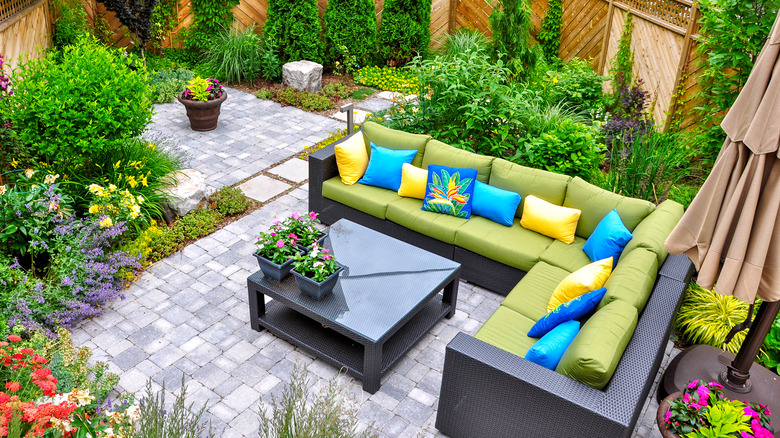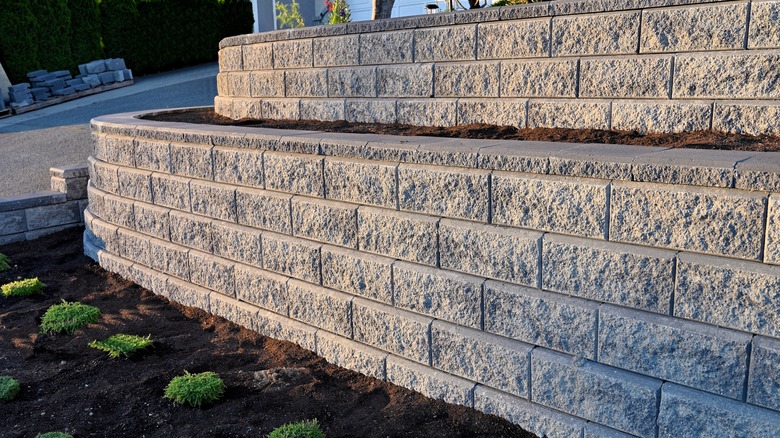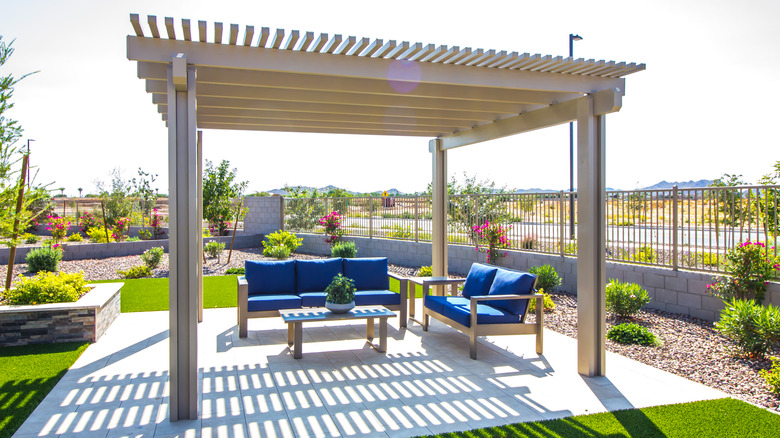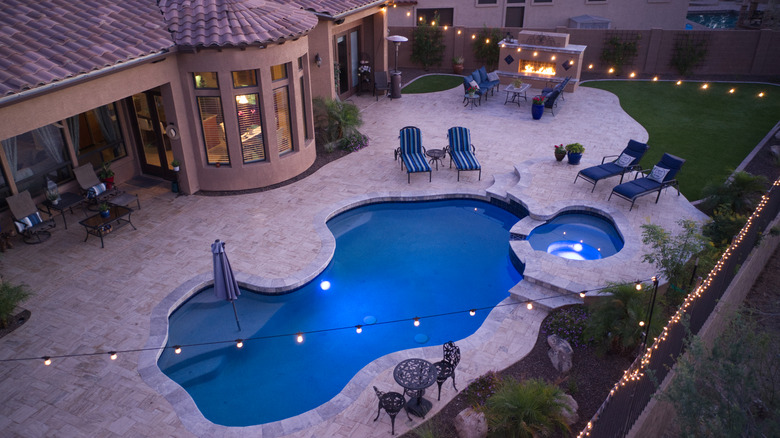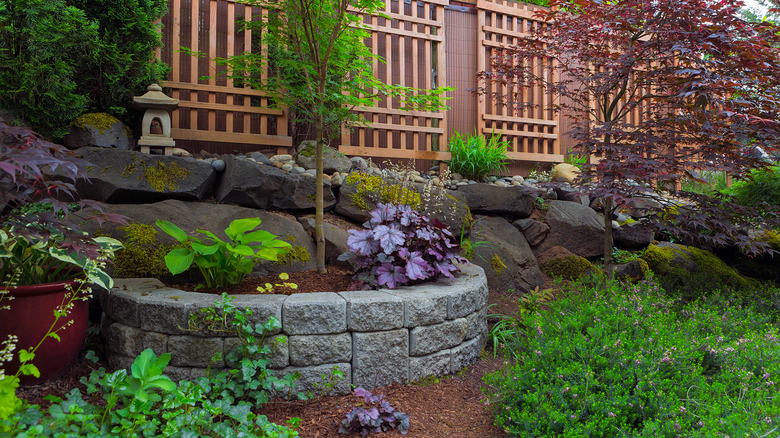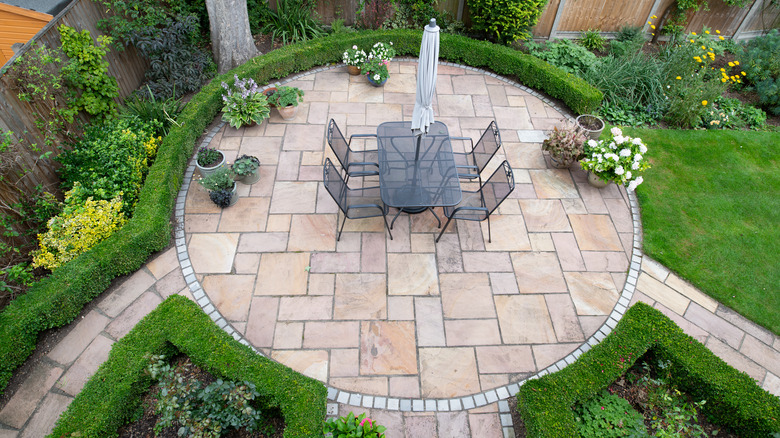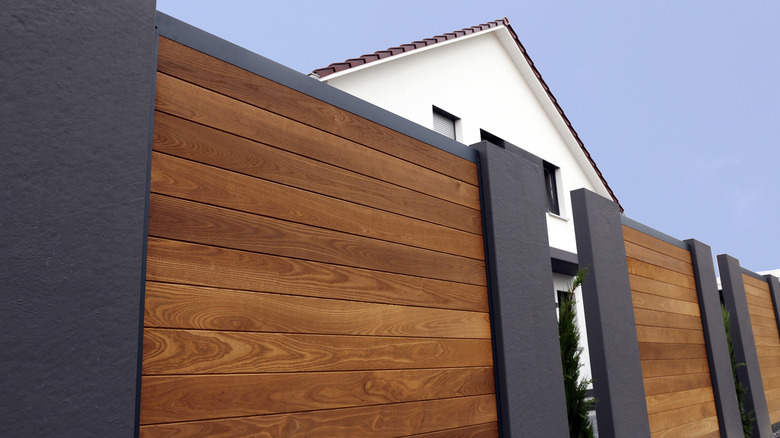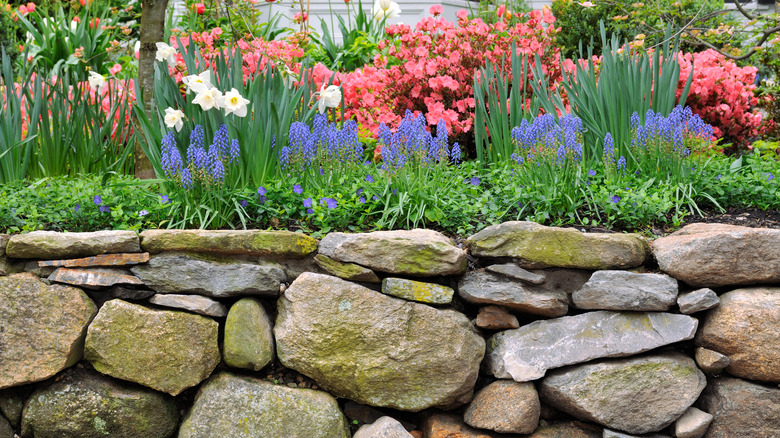What Is Hardscaping In Your Yard?
Hardscaping is an essential facet of your landscape's design that describes manufactured structures made of non-living materials. Hardscapes cover a wide range of landscaping structures, including concrete patios, wooden pergolas, stone walkways, and much more. According to Optima, this outdoor styling option can be traced back to the ancient origins of landscape design, with hardscaping being integrated into old Japanese gardens, along with water features. Even George Washington utilized hardscapes at his Mount Vernon estate, per Mount Vernon Ladies' Association, to separate different sections of the beautiful property.
Today, hardscaping is just as popular as ever due to its practical and aesthetic uses. In truth, expertly-applied hardscapes are utilized by landscape designers worldwide to transform landscapes so that they can support a wider variety of natural elements, as well as human use. If you love relaxing outside your home, the chances are that you'll be open to taking advantage of hardscapes nearly every single day.
Types of hardscapes
Many hardscapes you will find around modern homes are constructed solely for the enjoyment of human occupants. These include the patio in the backyard of a residence, fire and BBQ pits, and walkways that connect one part of a landscape to another. According to Reliance Foundry, some hardscape options are used for managing water and erosion, making it possible for homeowners to enjoy large pools or artificial ponds without destroying the rest of their yard. Pergolas and gazebos are also incredibly popular, especially for homeowners with a yard that doesn't provide ideal outdoor locations to find shade.
Other hardscapes, such as stone retaining walls, are employed to support plant life when the surrounding landscape doesn't provide suitable conditions for a thriving garden. These are very common in hilly yards, where managing your soil's water level can be difficult. Fountains are another popular water-centric hardscape option. While these can create a beautiful focal point for homeowners, per MasterClass, they can also provide local wildlife with a way to refresh themselves.
How much does hardscape work cost?
Since hardscapes cover a vast array of structures, materials, installation methods, and more, there's no one-size-fits-all method for determining the cost of hardscaping services. Complicating this is the fact that landscape designers and landscape architects usually offer prices that are unique to their clients' specific areas. As such, you are likely to pay less for a neighborhood with a lower cost of living, especially if there is plenty of competition driving down the cost of landscaping services.
That being said, it's possible to estimate the cost of popular hardscaping services. For instance, those seeking a brand new patio can expect to pay over $3,000 and may shell out about $8,000 if opting for premium materials. Having a custom pergola built will come with a similar price tag, although smaller structures will cost considerably less than large, intricate designs. According to Yardzen, you can also expect to pay between $15 to $50 per square foot for solid hardscaping such as stone patios, walkways, or driveways. Of course, your landscape's unique characteristics will also contribute to the overall cost since it will significantly affect the labor required for the job.
Can hardscaping increase your home's value?
If you're planning on selling your home, it might be worthwhile to touch up your hardscapes to maximize your ROI. According to HomeLight, hardscaping is especially common in high-end properties as potential homeowners want as much usable outdoor space as possible. However, your yard's hardscapes should make sense regarding your home's geographic location and surrounding landscape.
For instance, outdoor kitchens and dining areas are an enticing combination, particularly in areas that regularly feature a warm climate. However, if you have a barren yard with few trees to provide shade, a pergola or canopy should be considered to help you achieve the highest selling price for your home. If you live in an arid state that makes growing a lush lawn a struggle, you can use hardscapes to make your yard a more inviting space for potential homeowners. Structures such as colored concrete walkways or permeable pavers can go a long way in adding character to a grass-free yard.
Hardscape materials
Different hardscaping materials each have their own unique pros and cons. Thus, it is critical to select the best variety for your yard and its structures. If you seek a material filled with rustic charm that isn't difficult to maintain, you might opt for brick hardscapes. Brick structures are known to be durable and keep their color over time, per Hittle Landscape. However, bricks will leave you limited in color and can be pretty expensive to implement compared to other materials.
Stone hardscapes are another excellent option for homeowners who prefer to minimize the maintenance required to keep their hardscapes looking great. Also, it offers more variety than bricks in terms of size, color, and shape. However, stone can be rough for the soil underneath a hardscape since it can block moisture from being retained. Another stellar material that can afford your yard a refined look is wood. While wood is less durable than the previously mentioned materials, it's often more affordable to implement and is incredibly versatile, meaning it'll look great in a wide range of landscapes.
Caring for hardscapes
Hardscapes can be a significant investment, so learning how to maintain the variety in your yard is a no-brainer. According to The Seattle Times, you should regularly sweep or wash stone hardscapes, such as patios or walkways, to minimize the amount of organic debris that finds its way onto your yard's structures. Organic materials can leave hard-to-remove stains on stones, especially when left on the surface of your hardscape for weeks on end.
Another major issue that you'll want to keep an eye out for is pooling water on your flat hardscapes. While your landscape designer likely took pains to avoid water damage, it might be worth giving them a call if you notice excessive water on your patio, pavers, or retaining wall. Also, if you see any weeds poking out of the cracks of your hardscapes, it's crucial to eliminate them as soon as possible, per Landscape Creations.
Pros and cons of hardscapes
Depending on your situation, opting for an extensively hardscaped yard can have benefits and drawbacks. According to Homescape Now, implementing a variety of hardscapes in your yard can save you a lot of water compared to the demands of quenching an entire lawn in a drought-prone climate. Additionally, many homeowners find that you get more bang for your buck when paying for professional hardscaping services over comparably-priced softscapes. This is because hardscapes typically outlast just about any softscape with only a bit of routine maintenance. Furthermore, hardscapes are great for making outdoor spaces more functional, ensuring that they're an excellent investment for homeowners who like to spend time outdoors or throw backyard gatherings.
However, hardscapes come with a set of drawbacks. If implemented incorrectly, this type of outdoor styling can have devastating effects on your soil's water retention and cause harm to surrounding softscapes. Another, perhaps the biggest drawback for most homeowners is the cost of professional hardscaping. Transforming your yard via professionally-installed hardscapes represents a significant investment for most homeowners. As such, don't be surprised if your dream backyard with its paver patio and elegant pergola costs you over $10,000 after all is said and done.
Benefits of hardscapes
You may love your current yard, but it can be even better with professionally-installed hardscapes. To find out how investing in hardscapes can improve your time outdoors, consider the various shortcomings of your outdoor spaces. For instance, if your yard welcomes the prying eyes of nosy neighbors, you may consider investing in a wall or fence to help give you a feeling of privacy and security when you're lounging around in your backyard. According to Allen Outdoor Solutions, hardscapes can also be used to protect your yard's natural elements. For instance, if guests have been damaging your lawn with their meandering footsteps, investing in a brick or stone walkway will encourage visitors to walk a predetermined route when on your property.
Even if lush softscapes give your yard its unique character, implementing subtle hardscaping throughout your space can help your garden beds and foliage stand out. Without contrast, a yard featuring a variety of softscapes can seem cluttered and disorganized. However, mixing in inorganic structures can help draw attention to your favorite softscapes while also improving your yard's grading so that your gardens can thrive.
